1664-1714. Early life
The last of England's Stuart monarchs, Queen Anne, the younger daughter of James II and Anne Hyde, was born on 6th February, 1664 at St. James' Palace, London.
Anne suffered from a weakness in her eyes from childhood and was sent to France to consult an oculist when she was four years old, she was to remain very short-sighted all her life and suffered from a squint.
Queen Anne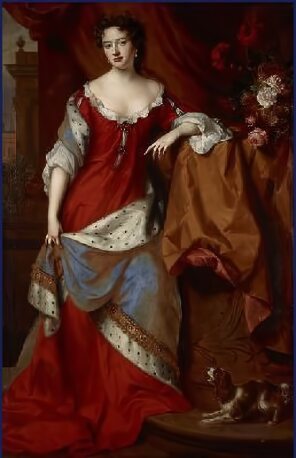
She spent the first part of her visit with her French grandmother, Henrietta Maria, but when the Dowager Queen died Anne went to live with her Aunt Henriette Anne, Duchess of Orleans, informally known in the family as 'Minette'. Minette was taken violently ill in 1670, and died soon after amongst rumours of poison. Her five year old niece was then returned to her parents in England.
Anne's mother was mortally ill, she is suspected of breast cancer. Anne had not been back in England a year when Anne Hyde died, she was only six, possibly too young to remember her mother well. Sarah Jennings, a girl older than herself, became a firm favourite, with whom she formed a close relationship, Sarah later married a young army officer, named John Churchill.
PRINCE GEORGE OF DENMARK
A marriage was arranged for Princess Anne with Prince George of Denmark (pictured right), a good-looking young man, who was tall and blonde. The marriage took place on 28th July 1683. Despite his good looks, George was rather dull and stupid, he also had a rather unpleasant fondness for the bottle. Charles II rather unkindly said of George " I have tried him drunk and I have tried him sober and there is nothing in him."
Prince George of Denmark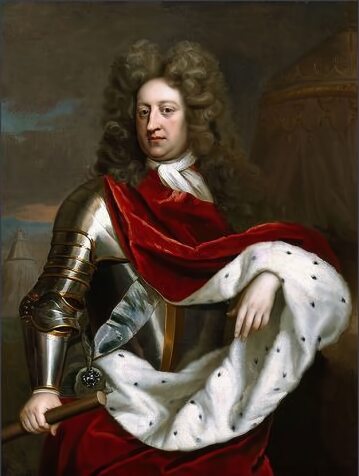
Anne and George, however, became devoted to each other. After her marriage, her favourite Sarah Jennings was appointed as her Lady of the Bedchamber.
William of Orange landed in 1688, the Protestant Anne deserted her Catholic father, a heartbreaking experience for him, despite his many faults he had been a doting father to both his daughters. William and Mary were jointly offered the throne. The two sisters had an emotional reunion on Mary's return from Holland, which unfortunately did not endure and they soon fell into disagreement. Anne came to strongly resent William's much voiced low opinion of her husband.
RELATIONS WITH MARY
Anne's relations with her sister Mary continued to deteriorate, Anne added to the growing ill-feeling by calling William such names as "Caliban" and "the Dutch abortion" behind his back. When Sarah's husband, John Churchill, was sent to the Tower, Anne openly sided with the Churchills against her sister. Finally, they ceased to communicate.
Jennings influence over Anne grew steadily. Sarah was one of the great beauties of her age, Anne suggested that they should correspond with each other as Mrs Morley (Anne) and Mrs Freeman (Sarah) to demonstrate the equality of their relationship.
Mary died of Smallpox in 1694, but coldly, Anne did not even visit her on her deathbed. A surprising but superficial reconciliation took place between Anne and William, even the previously detested Churchill was received back into the royal favour.
In 1701, James II died at St. Germain in France. Anne received a letter from her stepmother, Mary of Modena, informing her that before he had died James forgave her and asked her to make reparations to his son. Anne sent no reply to the letter. but she did go into mourning for her father, an act which evoked the annoyance of William. In February 1702, William III himself died, making Anne Queen of England and Scotland at the age of thirty-eight.
WILLIAM DUKE OF GLOUCESTER
Anne had eighteen pregnancies in all but of these only three of her children survived, two daughters, Mary and Anne Sophia, both died in infancy of smallpox. A daughter, Mary born on 14 October 1690, lived for only about two hours and a son George born on 17 April 1692 lived but a few minutes. William, Duke of Gloucester was her only surviving child. Her figure ruined, Anne was now obese and decidedly middle-aged, she also began to suffer very badly from gout.
William, Duke of Gloucester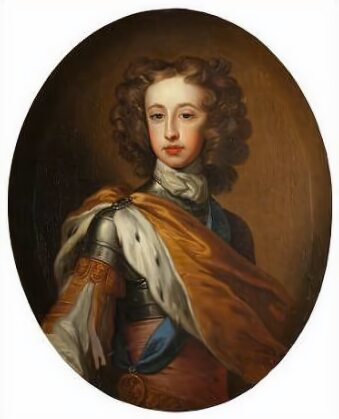
At 5 am on 24th July, 1688, at Hampton Court Palace, Anne was delivered of a son, who was christened William Henry. King Willliam III, his uncle, stood as one of his godfathers. The other godparents were his uncle King Christian V of Denmark, and the Marchioness of Halifax. and he was later announced Duke of Gloucester.
William's health was poor throughout his life. He suffered convulsions soon after he was born, his parents feared he would die and he remained a constant source of anxiety to his adoring parents. William suffered from hydrocephalus, or water on the brain, an incurable condition and was unable to walk unaided at the age of five. The symptoms of hydrocephalus include an enlarged head, problems with balance, poor coordination, difficulty walking, slowing or loss of developmental progress, lethargy and drowsiness. The illness affected William so badly that he could not walk alone because the movement of fluid in his head when he did so made him giddy. Intermittently, his surgeons pierced his head and drew off the fluid. All his short life was punctuated by regular attacks caused by his condition.
A contemporary wrote of him 'His head was extremely long and large, which made him very difficult to be fitted with a wig. His hat, poor infant, at five years old, was large enough for most men!'
William was said to be close to his uncle and namesake William III, who created him a Knight of the Garter at St. George's Chapel, Windsor on his seventh birthday. His aunt Mary, who was equally fond of him frequently sent him presents and visited him at his nursery in Campden House. At Kensington, Gloucester befriended his Welsh body-servant, Jenkin Lewis, whose memoir is an important source for historians. With Lewis, the boy operated his miniature army, called the "Horse Guards", eventually comprising 90 boys.
William celebrated his eleventh birthday on 24 July 1700 with a banquet and firework display at Windsor Castle. Always a delicate child, he complained of feeling unwell the following day and tragically, his condition continued to deteriorate. His mother kept an agonizing vigil at his bedside, he died at around 1 a.m. on 30 July 1700, with both his parents at his bedside. An autopsy revealed he had severe swelling of the lymph nodes in the neck and an abnormal amount of fluid in the ventricles of his brain.
In his book 'The Sickly Stuarts: The Medical Downfall of a Dynasty' Frederick Holmes analyzed the report of the autopsy. He wrote - "This autopsy report painstakingly describes inflammation and infection in the throat and larynx, with a grossly swollen neck and pus expressed from lymph nodes in this region. The lungs are described as both being full of blood, likely this was pus or fluid stained with blood. Put in context with the clinical course of the illness, this is a picture of an acute bacterial infection of the throat with an associated pneumonia in both lungs." Holmes further writes, "Interestingly, the surgeons opened the head and took fluid from the ventricles, and found it to be greatly increased in amount.This confirms the diagnosis of hydrocephalus."
William III, who was in the Netherlands at the time, wrote "It is so great a loss to me as well as to all England, that it pierces my heart." The young William was buried in Westminster Abbey on 9th August.
There is evidence to suggest that Anne saw the death of all her children as God's punishment for the way she had treated her father. She was ridden with a guilt complex about her desertion of the father she was never to see again.
REIGN
Three days later Anne addressed Parliament as Queen. Her dress was modelled on one worn by Elizabeth I, she drew a further parallel with the great Queen by stressing that she was "entirely English" as Elizabeth had done when succeeding her sister Mary and her unpopular foreign husband. Anne assured Parliament that there was nothing she would not do to promote the "happiness or prosperity of England".
Queen Anne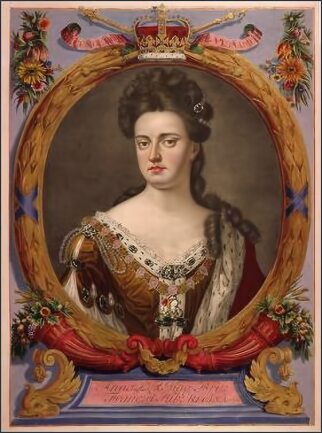
On 4th May, 1702, England declared war against France. Churchill, leading the Queen's troops, experienced early successes in the war and was rewarded by being created Duke of Marlborough. He went on to gain a historic victory over the French at Blenheim in Bavaria. Anne held a thanksgiving service at St. Paul's and granting him the royal estate at Woodstock and ordered Blenheim Palace built on the site at the expense of the nation. A Further victory followed at Ramillies in Flanders.
Louis XIV consequently gave aid to Anne's Catholic half-brother, and claimant to her throne, James Francis Edward. A French fleet was assembled at Dunkirk in 1708. Whilst meeting with her Council to discuss the matter, the question of whether James should be executed if taken prisoner was raised, Anne became so moved and emotionally upset that she could not carry on with the meeting. James, unfortunately, came down with measles just as his fleet was about to set sail, the threat was removed and the French fleet chased north.
SARAH CHURCHILL
Sarah Churchill, always a quarrelsome woman, was growing increasingly jealous and at times vehement at Anne's growing attachment to her cousin, Lady Masham. Marlborough, a gifted general, won a further victory against the French at Oudenarde and entered France, capturing Lille, he went on to gain a further resounding victory over Louis XIV at Malplaquet.
Sarah's now stormy relationship with Anne, however, was growing successively more strained. On the way to the Thanksgiving Service at St. Paul's to celebrate the victory of Oudenarde, Sarah provoked an embarrassing public scene, which culminated in her audaciously telling the Queen to "be quiet" on the steps of the Cathedral. Anne could not forgive this public humiliation and it widened the breach between them into a gaping chasm.
Although the crowns of England and Scotland had been united in the person of James I, they had continued to retain their separate Parliaments. In 1707, both the English and Scottish Parliaments passed the twin Acts of Union, creating the joint kingdom of Great Britain. The act was not popular in Scotland.
George of Denmark fell seriously ill in October 1708. Sarah visited Anne and was with her when her husband died to offer her support. Queen Anne was devastated. Sarah, true to character, untactfully continued to raise old quarrels with the grieving Queen and would not let the matter rest. Anne's patience with the fractious Sarah was wearing very thin.
Queen Anne in later years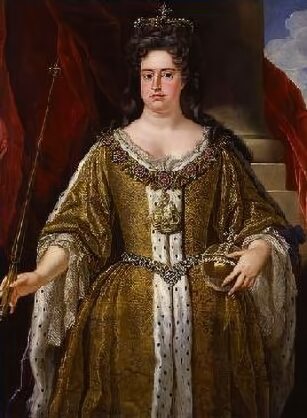
Sarah wrote requesting an audience, the Queen, trying to avoid the dreaded ordeal of another meeting with her, wrote that she would be unable to see her until after Easter. Undeterred, Sarah arrived before Easter and characteristically proceeded to bring up a matter of contention, Anne had had enough, the two were never to meet again. At the end of the war the great Marlborough was dismissed from office. It was a poor reward for the services he had rendered his country and the Queen.
James Francis Edward Stuart with his son, Bonnie Prince Chsrlie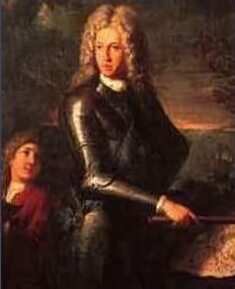
THE FINAL YEARS
As Anne entered the final years of her reign and her health declined, the issue of who should succeed her on the thrones of England and Scotland became of mounting importance. Anne personally disliked the Hanoverians, whom the succession had been settled on by an Act of Parliament. Sophia of Hanover's son, George, had at one point been sent to England as a prospective suitor for Anne's hand, but after meeting her failed to propose, Anne could not forget this stinging insult to her feminine pride.
It was suspected that Anne naturally preferred the claims of her half-brother, James, known as the Pretender. The Queen herself fueled such rumours by refusing to allow any of Sophia of Hanover's family to reside in England. In 1712 Anne received a letter from the brother she had never met, asking her to 'prefer your own brother, the last of our line,' he received no reply but she refused to countenance the suggestion of Parliament's putting a price on his head.
When Sophia of Hanover wrote to request that her grandson might take up his position in the House of Lords, Anne's response was furious. Her letter to Sophia was cold and dismissive. Sophia, whose greatest wish was said to have had 'Sophia, Queen of Great Britain' inscribed on her tomb, narrowly missed her ambition when she died suddenly at Hanover just a few months before Queen Anne on 8th June 1714. On 27th July Anne finally decided in favour of the Hanoverian succession.
At half-past seven on the morning of 1st August 1714, England's last Stuart monarch, now vastly obese and ailing, died at Kensington Palace. Arbuthnot wrote, "sleep was never more welcome to a weary traveller than death was to her." The Queen's body was so swollen with dropsy at her death that she had to be interred in a vast, square-shaped coffin. She was buried beside her husband George of Denmark at Westminster Abbey and was succeeded by George I, the first of the House of Hanover.
Mary II PreviousNext Anne of Denmark
